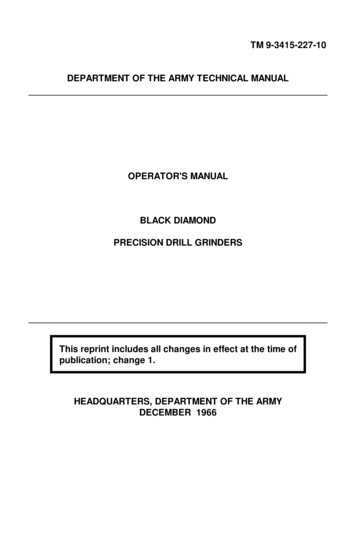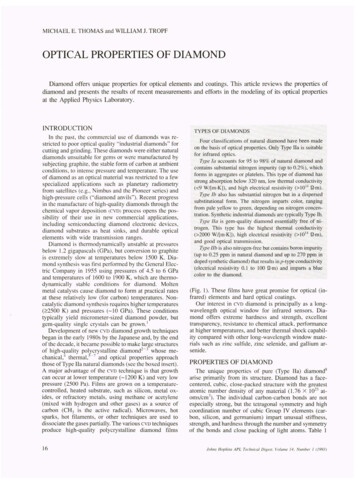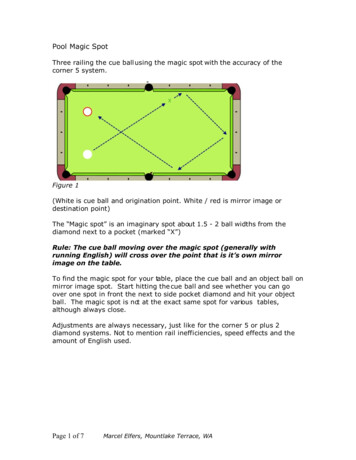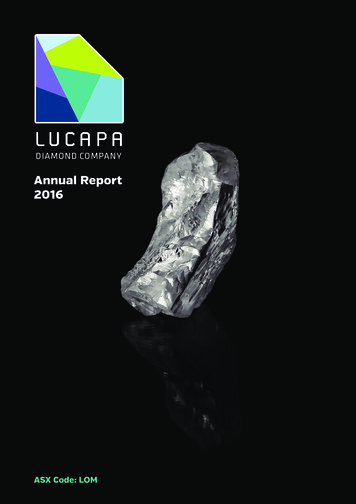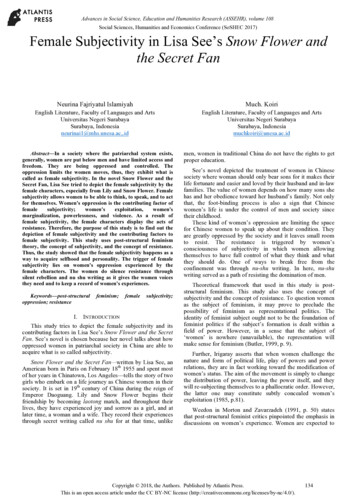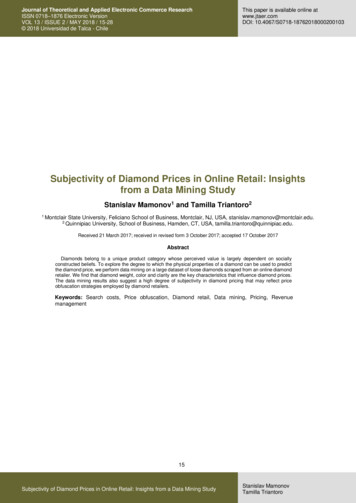
Transcription
Journal of Theoretical and Applied Electronic Commerce ResearchISSN 0718–1876 Electronic VersionVOL 13 / ISSUE 2 / MAY 2018 / 15-28 2018 Universidad de Talca - ChileThis paper is available online atwww.jtaer.comDOI: 10.4067/S0718-18762018000200103Subjectivity of Diamond Prices in Online Retail: Insightsfrom a Data Mining StudyStanislav Mamonov1 and Tamilla Triantoro21 MontclairState University, Feliciano School of Business, Montclair, NJ, USA, stanislav.mamonov@montclair.edu.University, School of Business, Hamden, CT, USA, tamilla.triantoro@quinnipiac.edu.2 QuinnipiacReceived 21 March 2017; received in revised form 3 October 2017; accepted 17 October 2017AbstractDiamonds belong to a unique product category whose perceived value is largely dependent on sociallyconstructed beliefs. To explore the degree to which the physical properties of a diamond can be used to predictthe diamond price, we perform data mining on a large dataset of loose diamonds scraped from an online diamondretailer. We find that diamond weight, color and clarity are the key characteristics that influence diamond prices.The data mining results also suggest a high degree of subjectivity in diamond pricing that may reflect priceobfuscation strategies employed by diamond retailers.Keywords: Search costs, Price obfuscation, Diamond retail, Data mining, Pricing, Revenuemanagement15Subjectivity of Diamond Prices in Online Retail: Insights from a Data Mining StudyStanislav MamonovTamilla Triantoro
Journal of Theoretical and Applied Electronic Commerce ResearchISSN 0718–1876 Electronic VersionVOL 13 / ISSUE 2 / MAY 2018 / 15-28 2018 Universidad de Talca - ChileThis paper is available online atwww.jtaer.comDOI: 10.4067/S0718-187620180002001031 IntroductionDiamonds are a very unique consumer product. At the first glance, there is no apparent utility of owning a diamond.Although it is considered the hardest gem, that is 58 times harder than anything else on Earth [19], few people usediamonds for this utility. One of the most apparent reasons for owning or wearing diamonds lies in their perceivedvalue as being rare and expensive objects. Although diamonds have been considered valuable objects for millennia,the consumption of diamonds significantly changed in the 20th century when it became customary to give diamondrings as engagement gifts. De Beers, the largest player in the diamond industry, has been using a slogan ‘a diamondis forever’ to encourage such gifts since 1948 [42]. Global sales of diamond jewelry in 2015 reached 79 billion, withthe United States being the largest market, contributing 39 billion to total sales [5]. The demand for polished loosediamonds, globally was 25 billion in 2014 [4]. The top five markets for diamonds are the United States, China, India,Japan and the Persian Gulf region.Traditionally diamonds were sold in jewelry stores. The Diamond District in New York City and the Diamond Quarterin Antwerp have been global centers for diamond trade. With the proliferation of electronic commerce, more diamondsare sold on the Internet, allowing for a broader consumer reach. While the perceived value of a diamond may beaffected by the price paid [32], diamonds also have well-defined physical properties: weight, cut and color among them.In addition to expanding the potential markets for diamonds, the growing popularity of online commerce is expected toreduce the consumer search costs and make it easier for consumers to compare diamond prices in relation to diamondphysical properties and do so across different retailers [1]. The reduction in the online consumer search costs and theease of comparing physical diamond properties through online search would be expected to make diamonds more likea commodity product, whose value is determined by the physical characteristics.The goal of our research is to explore the relationship between the physical properties of diamonds and diamond pricesto understand the degree to which diamond prices are determined by the physical characteristics. To answer thisquestion, we perform data mining on a large dataset of diamonds available for sale at one of the largest online diamondretailers. The emergent insights contribute to our understanding of the relationship between the consumer search costsand variation in product prices for diamond goods. The results also have broader implications for the effects of onlinecommerce on luxury goods pricing as well as on the potential strategies for retailers to overcome the pricing pressurecreated by e-commerce.The paper is structured as follows. First, we provide an overview of prior research on consumer search and productprice variation. Next, we review the key diamond physical properties that are known to affect diamond prices. We thendiscuss the literature on price obfuscation or retailer strategies to increase consumer search costs. After that, wedescribe the dataset, the methodology and present the data mining insights. We conclude with the discussion of theresults, contributions and future research directions.2 Search Costs and Price DispersionThe extant research on consumer product information search and price dispersion provides the theoretical foundationfor our work. Price dispersion - the variation in price for the same product across different retail channels - has beenstudied in economics [2], [38]. Price dispersion arises due to the information asymmetry and imperfect consumerinformation [2]. When consumers are differentially informed, firms can charge consumers different prices [38]. In orderto find the price, consumers have to spend resources on search, and the search for product prices can be costly. Thehigher the consumer search costs, the greater the expected price dispersion in a given product category [2].The Internet adds transparency and efficiency to the markets by providing valuable information about goods in oneplace [23]. It offers temporal and spatial shopping convenience and adds value through price comparison opportunities[16], [27]. It has long been proposed that the Internet reduces search costs and information asymmetry by putting allinformation at the consumer’s fingertips [1]. The Internet is also known to increase the product selection and productavailability via the Long Tail phenomenon [8]. The Long Tail refers to the fact that Internet-based retail can effectivelyservice the demand for niche products, which are generally not offered by physical retailers due to the relatively lowdemand for each individual niche product. The early theoretical work on the effects of the Internet on online retailerssuggested that given the low cost of online information search for consumers, online retailers would be expected toexperience price competition that would eventually lead to price convergence for almost all goods offered on theInternet [1]. This is known as the law of one price. Subsequent research has shown that information intermediariescan make it easier for consumers to find the best price by aggregating pricing information across multiple retailchannels [12], [22].Although some studies found that price dispersion may be decreasing due to the growing popularity of e-retail [33],the empirical evidence has not always supported the theoretical predictions of price convergence driven by ecommerce [18], [28], [44]. For example, in the early stages of e-commerce, the prices for books and CDs varied asmuch as 50% across online retailers [1]. Similar observations have been made in the digital cameras market [3]. Thesefindings were initially attributed to the immaturity of online markets [3], but a literature review spanning four decades,16Subjectivity of Diamond Prices in Online Retail: Insights from a Data Mining StudyStanislav MamonovTamilla Triantoro
Journal of Theoretical and Applied Electronic Commerce ResearchISSN 0718–1876 Electronic VersionVOL 13 / ISSUE 2 / MAY 2018 / 15-28 2018 Universidad de Talca - ChileThis paper is available online atwww.jtaer.comDOI: 10.4067/S0718-18762018000200103suggests that price dispersion is the rule in markets with homogenous products in both offline and online markets andprice dispersion commonly reaches 30 percent [2]. Further, theoretical arguments have been made that pricedispersion may actually benefit consumers as well as vendors in some industries [34]. Recent studies across differentindustries show that even with the growing popularity of e-commerce significant price dispersion persists in manyindustries [25], [40].3 Online Diamond Retail and Diamond CharacteristicsOne of the benefits of online diamond markets for consumers is the availability of all diamond related information inone place. Online diamond retailers also commonly enable the consumers to compare diamonds by creatingdashboards with search attributes to assist in the diamond selection process. Reputable online diamond retailersprovide images, detailed descriptions and certifications, and they offer money-back guarantees. The online diamondcollections are vast and may include information on more than 100,000 diamonds of various shapes and attributes[45].The most well-known attributes pertaining to diamonds are the 4Cs introduced by the Gemological Institute of America(GIA) in the 1950s - Cut, Carat, Color and Clarity. The 4Cs describe the unique qualities of each diamond and greatlyinfluence diamond prices. Three of the 4Cs have a long history: carat weight, color, and clarity were used in the firstdiamond grading system created in India over 2,000 years ago [20].The cut refers to a diamond’s proportions and determines how well it reflects light. The cut scale ranges from poor toexcellent. The cut of a diamond has additional three attributes: brilliance, or the amount of light reflected from adiamond; fire, or the dispersion of light into the colors of the spectrum; and scintillation, the flashes of sparkle when adiamond is moved around [21].Carat is a standard unit of weight and corresponds to a diamond’s size. One carat equals 0.2 grams. The name caratcomes from the carob seed. Back in the day, traders started using carob seeds because of their fairly uniform weightto counterweight their balance scales. Only one in 1,000 diamonds weighs more than one carat. [20].The color ranges from D for colorless to Z for a diamond with a hint of yellow or brown. Colorless diamonds have moresparkle and brilliance, thus diamonds graded D through F are considered superior and more expensive. Most colordistinctions are subtle and almost unnoticeable to a human eye, but can greatly affect the price of a diamond.The clarity corresponds to the lack of inclusions or natural flaws that a diamond has. Highly praised diamonds areflawless, and contain no inclusions or blemishes. The GIA Clarity Scale contains 11 grades from Flawless to Included.The majority of diamonds fall into categories of very slightly included (VS) or slightly included (SI) [21].Another important attribute of a diamond is its shape. There are about ten popular shapes of the diamonds. A roundshape is the most prevalent shape as it is considered to be the shape that reflects light exceptionally well. Otherpopular shapes, sometimes called fancy shapes, are princess, cushion, pear, radiant, marquis, asscher, oval, heart,and emerald.In addition to 4Cs and the shape, there are many other attributes of diamonds such as polish, depth, table, symmetry,fluorescence and, of course, price that ranges from a few hundred to tens of millions of dollars. Prior research on theeffects of diamond characteristics on price suggests that the diamond weight is the key factor affecting price [43] andthat the degree of price dispersion increases with the diamond weight [45].4 Price ObfuscationIn addition to the research focusing on the consumer search costs and overall market efficiency, there is also a parallelstream of studies that focuses on the retailer strategies for achieving price premiums and consequently increasingprice dispersion. Price obfuscation refers to a number of different strategies that can be employed by retailers to makeconsumer search more costly and thus potentially increase price premiums. The research on price obfuscationsuggests that product versioning and bundling can be used to make consumer price comparison more difficult [33].Ellison and Wolitzky [14] suggest that online price obfuscation can take the form of providing the number of screensthat a consumer must click through before the final price is known, including upgrades, shipping costs and service feesas well as the time that it takes each screen to load. Researchers have also advocated experimentation with pricediscrimination - offering the same product at different prices to different customers based on inferred willingness to pay[1].While product information disclosures potentially make consumers more informed, too many details and informationattributes, and the lack of understanding of price formation may complicate consumer decision-making. In the scenariowhen prices are available, but obfuscated by the difficulty of search, the consumers may search less, the prices ofgoods will be higher on average and there will be more price dispersion.17Subjectivity of Diamond Prices in Online Retail: Insights from a Data Mining StudyStanislav MamonovTamilla Triantoro
Journal of Theoretical and Applied Electronic Commerce ResearchISSN 0718–1876 Electronic VersionVOL 13 / ISSUE 2 / MAY 2018 / 15-28 2018 Universidad de Talca - ChileThis paper is available online atwww.jtaer.comDOI: 10.4067/S0718-18762018000200103In online retail, sellers may opt for a tactic of increasing consumer search costs by presenting too much information.When consumers feel overwhelmed by search results, they may end up purchasing goods at suboptimal prices. Inonline diamond markets, considering the number of information attributes that a buyer has to select from, theobfuscation can result from the overwhelming effects of selecting the right diamond among the pool of available gems.For example, at the time of writing, an online diamond retailer JamesAllen.com offered 90,000 loose diamonds forsale [31], Brilliance.com had 154,000 loose diamonds on their website [31], and BlueNile.com’s collection consistedof 165,500 loose diamonds [31].Considering that there are multiple attributes pertaining to each diamond, including 4Cs, price, shape, polish,fluorescence, symmetry, table, depth, pavilion depth, crown height, culet, girdle, certifying agency, etc. the total numberof possible combinations of diamonds and their attributes can easily go over a million. Even after filtering diamond databy attributes, the number of possible combinations can be overwhelming. In addition, the majority of consumerspurchase diamonds once or several times in their lifetime, and are at a disadvantage of building the experience andfamiliarity with purchasing diamonds. The lack of experience coupled with the information overload may forceconsumers to rely on shortcuts - eliminating attributes that they are not familiar with and assigning more value toattributes that make sense to them.To assist consumers, almost all online diamond retailers include educational information and guidelines on how tochoose diamonds starting with the diamond shape, cut, carat, color, clarity and certification being the most essential,and polish, fluorescence, symmetry, table, depth, pavilion depth, crown height, culet, girdle being offered as well. Forexample, according to the International Gem Society, out of 4Cs, the cut is the most important attribute of a diamond,followed by color, clarity, and the least important carat [10]. According to Blue Nile, the cut has the biggest effect onthe sparkle, and even with perfect color and clarity, a poorly cut diamond will look dull [6]. However, the explanation ofwhich particular attribute affects the price the most is generally missing. For example, the GIA explains that in additionto other attributes, prices of diamonds are affected by the fact that “some weights are considered magic sizes: halfcarat, three-quarter carat, one carat, etc.” [20]. Diamonds whose weight is slightly above the magic one-carat size canincrease the price as much as 20 percent with only a 6-point difference in weight [20].Price obfuscation can potentially reduce a consumer’s ability to fully understand the prices. While we can safelyassume that larger and better quality diamonds fetch higher prices on the market, it may be difficult for consumers toascertain the fair value of a diamond based on its physical attributes. This fact coupled with the lack of experience withdiamonds for the majority of consumers, as diamond purchases are infrequent purchases, makes the understandingof prices even more challenging.In summary, prior research examining the interplay between the consumer search costs and price dispersion revealedthat the theoretical expectations of the reduction of price dispersion due the growing popularity of e-commerce andassociated lower consumer search costs were not supported by the empirical evidence from a number of differentproduct categories [9], [11], [33]. Prior research on price dispersion has been generally done comparing prices acrossdifferent retail channels [9], [11]. Diamonds are a unique product category. Consumers generally possess limitedknowledge about the relationship between the physical characteristics of a diamond and diamond prices. The relativelyhigh number of diamond physical characteristics: weight, shape, cut, clarity, color, fluorescence, length, width, height,table, etc., make it difficult for consumers to evaluate the effect of each characteristic on price. In addition, diamondretailers commonly offer tens of thousands of loose diamonds for sale, further complicating consumer search. Toexplore the degree of diamond price dispersion in the context of a single retailer, we perform predictive data miningfocusing on the predictive value of the physical characteristics in relation to diamond price in the context of a singlediamond retailer. In the next section, we discuss the dataset in our study and the analytical methodology thatprogresses through several stages to gain insight on the predictability of diamond prices.5 Data and MethodologyWe obtained the dataset for our study by scraping data from an online retailer that offers one of the largest collectionsof diamonds available for sale. The retailer operates several online storefronts targeting customers internationally. Welimited the data scraping to the web site that focuses on the consumers in the United States. We were able to collectdata about 138,654 diamonds. Although the retailer offers consumers an opportunity to incorporate the purchaseddiamonds into rings, earrings and other types of jewelry, we focused our analysis on the diamonds themselves,because while the loose diamond prices are relatively transparent on the retailer’s website, the jewelry prices weremore difficult to determine due to different types of discounts available through the retailer and third parties.Our analysis has been done in several stages. First, we present the exploratory analysis of our data. In the secondstage we develop a multiple linear regression model to predict diamond prices and assess its accuracy. In the thirdstage we expand our predictive modeling to include several data mining techniques that are able to capture non-linearrelationships among the predictor variables and price. Next, drawing on the evidence of actual diamond sales, wenarrow the range of diamonds in our analysis and reassess the accuracy of data mining models and key predictors ofdiamond prices. In the final stage of our empirical analysis we examine specific price discontinuities in the dataset.18Subjectivity of Diamond Prices in Online Retail: Insights from a Data Mining StudyStanislav MamonovTamilla Triantoro
Journal of Theoretical and Applied Electronic Commerce ResearchISSN 0718–1876 Electronic VersionVOL 13 / ISSUE 2 / MAY 2018 / 15-28 2018 Universidad de Talca - ChileThis paper is available online atwww.jtaer.comDOI: 10.4067/S0718-187620180002001036 Analysis and ResultsWe obtained a set of attributes for each diamond. These attributes included diamond weight (measured in carats), cut,color, and clarity rating as well as the shape and physical dimensions of each diamond. Table 1 summarizes keydescriptive statistics for the dataset (N 138,654).Table 1: Dataset descriptive statisticsFeatureCarat uorescenceDescriptive statistics / DistributionMean 0.91, SD 0.8, Min 0.01, Max 22.74Mean 1.08, SD 0.18, Min 0.75, Max 2.95Mean 0.6, SD 0.04, Min 0.01, Max 0.82Mean 0.60, SD 0.05, Min 0.17, Max 0.85Good1751012.63%Very Good5785241.72%Ideal5919542.69%Sig. um Blue16611.20%Strong Blue7960.57%Very Strong2160.16%Faint Blue1950.14%Very Strong Blue550.04%Medium YellowPrice90.01%Other190.01%Mean 7,932.94, Median 2,345.47, SD 30,346.77, Min 223.00, Max 2,818,242.1619Subjectivity of Diamond Prices in Online Retail: Insights from a Data Mining StudyStanislav MamonovTamilla Triantoro
Journal of Theoretical and Applied Electronic Commerce ResearchISSN 0718–1876 Electronic VersionVOL 13 / ISSUE 2 / MAY 2018 / 15-28 2018 Universidad de Talca - ChileThis paper is available online atwww.jtaer.comDOI: 10.4067/S0718-18762018000200103As it is evident from the descriptive statistics, the dataset includes a very broad range of diamonds varying in weightfrom 0.01 to 22.74 carats and consequently varying in price from 223.00 to over 2.8 million. A weight/pricedistribution plot (Figure 1) shows that relatively few diamonds are over 10 carats in size and that price varianceincreases with the diamond weight.To reduce the heteroscedasticity in our dataset we limited further analysis to diamonds larger than 0.2 carats andsmaller than 10 carats by removing 71 records containing diamonds outside of this range. Following therecommendations in [30] to further reduce the heteroscedasticity in the dataset, we also transformed the weight andthe price of diamonds by taking a natural logarithm of these variables. Figure 2 illustrates the relationship following thetransformation. 3.000.000,00 2.500.000,00 2.000.000,00 1.500.000,00 1.000.000,00 500.000,00 05101520252,53Figure 1: Price versus diamond weight, carats161412108642000,511,52Figure 2: ln(Price) versus diamond weight, ln(carats)In the next step of the analysis, we examined the predictability of diamond prices using a multiple linear regressionmodel. We estimated the parameters in the following function:ln(Pi) α β*Xi δ*ln(Wi) εi(1)where ln(Pi) is the natural log of a diamond price20Subjectivity of Diamond Prices in Online Retail: Insights from a Data Mining StudyStanislav MamonovTamilla Triantoro
Journal of Theoretical and Applied Electronic Commerce ResearchISSN 0718–1876 Electronic VersionVOL 13 / ISSUE 2 / MAY 2018 / 15-28 2018 Universidad de Talca - Chile ln(Wi) is the natural log of the diamond weight Xi is the vector of the diamond’s features α, β, δ are estimated parameters εi is a random error term.This paper is available online atwww.jtaer.comDOI: 10.4067/S0718-18762018000200103To assess the quality of the linear regression model, we randomly split the dataset 70/30 into training and validationsubsets. We estimated the model parameters using the training dataset and we assessed the model performance byscoring the validation dataset using the model and comparing the model predictions to the actual prices. The averageprice, mean absolute error and mean absolute percent errors for the regression model using the validation data areprovided in Table 2. The definitions of the model performance metrics: Mean absolute error and Mean absolute percenterror, are provided in the Appendix A.Table 2: Multiple regression model performance summaryAverage price 14,987.07Mean absolute error 4,556.07Mean absolute percent error30.4%The results of the multiple regression model suggest that a linear model may not be the best way to capture the effectsof diamond characteristics on price. The mean absolute percent error is 30.4% implying a very high dollar pricevariation. In the next step of our empirical analysis we examined the ability of non-linear data mining techniques toaccurately predict diamond prices.Predictive data mining is the practice of building predictive models that can accurately forecast the target variable ofinterest [17]. Predictive data mining techniques can be generally separated into two general families of models.Classification models can be used to forecast a nominal target variable. Prediction models can be leveraged to forecastan interval numeric target variable. Diamond price is a continuous interval target variable that is based on a ratio scale,hence we employed the following prediction data mining techniques: decision forest, boosted decision tree, andartificial neural network. We also included the multiple linear regression model to provide the baseline to evaluate theimprovement in accuracy offered by the other techniques. The detailed discussion of the specific model types is beyondthe scope of the current manuscript. Here we will only provide a brief overview of the individual data mining techniques.Decision forest, also known as random forest, is an ensemble modeling technique which aggregates predictions acrossmultiple individual decision trees [7]. Decision tree algorithms are one of the fundamental data mining techniques [36].Several decision tree algorithms have been developed [36], but all share the general approach to building the tree.The decision tree algorithms iteratively partition the data in the training dataset and attempt to construct a set ofsequential hierarchical splitting rules that can partition the dataset in such a way that reduces variance within eachbucket of cases following the traversal through the decision tree. The decision rules are developed iteratively byconsidering potential binary data partitioning rules, for example weight 2 carats. Decision tree algorithms are greedy(focus on local optima) and therefore they tend to be globally suboptimal [36]. Decision trees also tend to over-fit thetraining data. Several ensemble data mining techniques have been developed that leverage the decision tree ability tocapture non-linear relationships in the data. The decision forest technique builds multiple decision trees bysubsampling data from the training dataset and also restricting the number of variables that are available for modelingwithin each tree [29]. The decision forest algorithm then estimates the value of the target variable by averaging thepredictions of the individual tree models.The boosted decision tree algorithm is another example of an ensemble model that is built on the foundation of thedecision tree algorithm [13]. The boosted tree algorithm builds a series of decision trees, but it takes a unique approachto improving the accuracy of the ensemble model by increasing the weights assigned to the records with the largesterror with each tree that is built (in our case, the error is the difference between the predicted and the actual diamondprice). In other words, after building the initial tree, errors are assessed and the next tree is built to minimize the errorsfor the records that the first tree had the largest errors for. The process is repeated iteratively increasing the weightsof the cases with the largest error in each round. Random forest and boosted decision trees afford the advantage ofcapturing non-linear relationships in data while safeguarding against overfitting the training dataset. This is in partaccomplished by putting aside an out-of-bag subsample while building the models and assessing the improvement inmodel accuracy after each tree is added the model by using the out-of-bag subsample. The modeling stops when themodels begin to over-fit the data as is indicated by an increasing error on the out-of-bag subsample.Artificial neural networks (ANNs) are an entirely different approach to modeling non-linear relationships in data. Artificialneural networks evolved from the attempts to model human brain functioning [46]. The artificial neural networks aretypically composed of nodes organized in input, inner and output layers. Each inner and output layer node functions21Subjectivity of Diamond Prices in Online Retail: Insights from a Data Mining StudyStanislav MamonovTamilla Triantoro
Journal of Theoretical and Applied Electronic Commerce ResearchISSN 0718–1876 Electronic VersionVOL 13 / ISSUE 2 / MAY 2018 / 15-28 2018 Universidad de Talca - ChileThis paper is available online atwww.jtaer.comDOI: 10.4067/S0718-18762018000200103as a processing unit receiving multiple inputs and sending a single output. The input nodes receive inputscorresponding to the predictor variables in the model. The inner layer nodes receive inputs from the input layer andtransform the inputs using a mathematical function, e.g. a logistic regression, the outputs of the inner layer nodes thenreceived as inputs by the output layer nodes. In case of modeling a single continuous numeric target variable there isa single output node. ANNs are trained by sending each record through the network, assessing the error on the outputnode and adjusting parameters affecting the output from each inner layer node iteratively with the goal of minimizingthe errors. This variant of the ANNs is referred to as feedforward, error backpropagation models. ANNs can capturecomplex non-linear relationships in the data, but they are typically seen as black box models that provide l
Subjectivity of Diamond Prices in Online Retail: Insights from a Data Mining Study Stanislav Mamonov1 and Tamilla Triantoro2 1 Montclair State University, Feliciano School of Business, Montclair, NJ, USA, stanislav.mamonov@montclair.edu. 2 Quinnipiac University, School of Business, Hamden, CT, USA, tamilla.triantoro@quinnipiac.edu.

